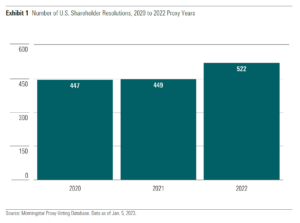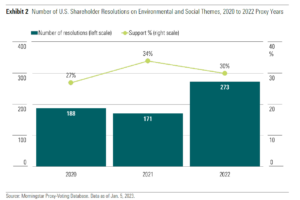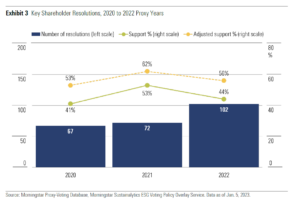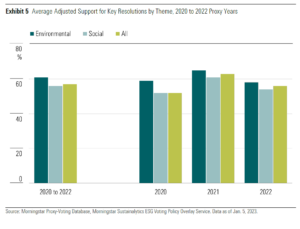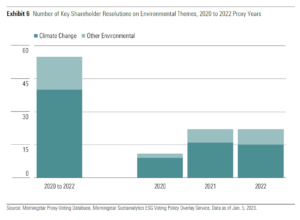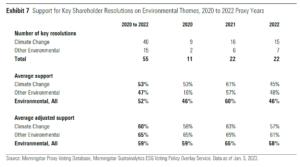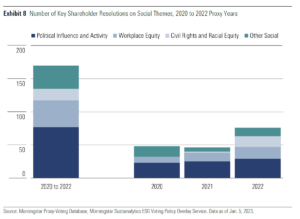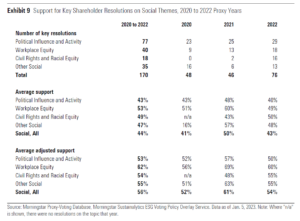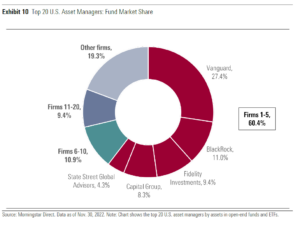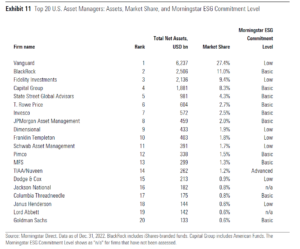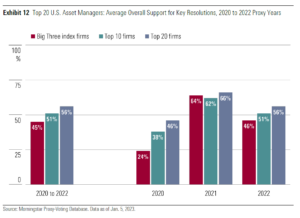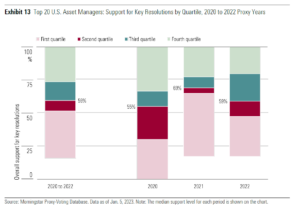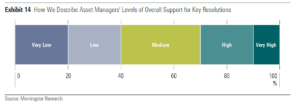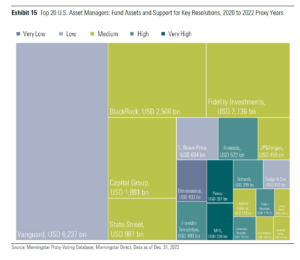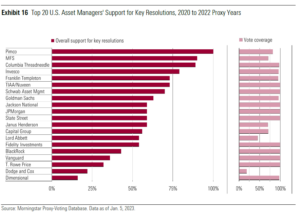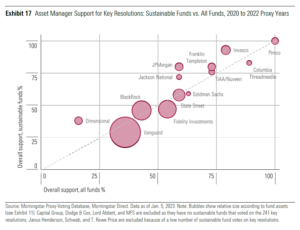Lindsey Stewart is Director of Investment Stewardship Research at Morningstar, Inc. This post is based on his Morningstar memorandum. Related research from the Program on Corporate Governance includes The Agency Problems of Institutional Investors (discussed on the Forum here) by Lucian Bebchuk, Alma Cohen, and Scott Hirst; Index Funds and the Future of Corporate Governance: Theory, Evidence, and Policy (discussed on the forum here) and The Specter of the Giant Three (discussed on the Forum here), both by Lucian Bebchuk and Scott Hirst; and The Limits of Portfolio Primacy (discussed on the Forum here) by Roberto Tallarita.
Executive Summary
The last year has seen the debate over sustainable investing come to a head. There has never been a greater range of views on how considering environmental, social, and governance factors affects investing. Amid all this debate, everyone seems to agree on one thing: proxy-voting decisions matter.
Asset managers believe that voting at shareholder meetings is an essential element of how they exercise their fiduciary duty on behalf of their clients. Yet, outside the asset-management industry, opinions are increasingly polarized. Some stakeholders think that asset managers aren’t using the influence of their voting power to address environmental and social issues at companies. Others believe managers are overprioritizing such issues to the detriment of investor returns. But, with 2022’s record number of shareholder resolutions on environmental and social issues, it’s hard to find anyone who believes that these votes are inconsequential.
Amid this unprecedented focus on voting, it is a good opportunity to take a deep dive into how the top U.S. asset managers voted on key shareholder resolutions at U.S. companies. We define these key resolutions as those shareholder resolutions addressing environmental or social themes that were supported by 40% or more of a company’s independent shareholders. At a time when asset managers have emphasized their reluctance to support proposals that they see as “unduly prescriptive” or repetitive of existing asks of companies, analyzing these key resolutions gives a clear picture of the levels of shareholder support for proposals that asset managers with a range of approaches to sustainability are prepared to back.
This paper analyzes the trends and key topics for shareholder resolutions over not only 2022 but also 2021 and 2020. It evaluates how the top 20 U.S. asset managers have voted on 241 key resolutions and how those managers’ sustainable funds have voted relative to the wider fund range.
Key Takeaways
- Out of the 241 key resolutions identified in the last three proxy years, last year’s 102 resolutions represented a steep increase from around 70 in each of the previous two years. (See Page 5.)
- Some key resolutions on the list have made headlines, such as the resolutions over the last two years on net-zero strategy at Exxon Mobil, on worker treatment at Amazon.com, on civil rights at Apple, or on platform misuse at Meta Platforms. But most represent the incremental changes to sustainability practice and disclosure that asset managers wish to see at investee companies in the interests of generating long-term value.
- The majority (170) of 2022’s key resolutions focused on various social issues, the three major ones being political influence and activity, equity in the workplace, and civil rights and racial equity. Fifty-five key resolutions targeted environmental themes, primarily climate. (See Pages 6–10.)
- Support for key resolutions fell in the 2022 proxy year to an average1 44% from a peak of 53% in 2021 amid the pushback on prescriptive proposals. On an adjusted basis (that is, only including votes cast by shareholders independent of the company), there was 56% support for key resolutions in the 2022 proxy year, down from 62% in 2021. (See Pages 6–7.)
- On average, the top 10 asset managers showed a lower level of support for key resolutions over the last three proxy years (51%) compared with the next 10 firms (72%). The average for the top 20 firms overall is 56%. The comparable average for the “Big Three” index firms—Vanguard, BlackRock, and State Street—was lower still at 45%. Vanguard showed considerably lower support (36%) for key resolutions than BlackRock (43%) and State Street (59%) over the last three proxy years. (See Pages 12–13.)
- Overall, only 13% of the top 20 U.S. managers [1] fund assets is run by managers that have shown a high or very high level of overall support for key resolutions in the last three proxy years. MFS and Pimco both cast more than 90% of their fund votes on key resolutions in support of them. Overall support for key resolutions by Columbia Threadneedle, Franklin Templeton, Invesco, Schwab, and TIAA/Nuveen exceeded 70%. (See Pages 15–16.)
- The sustainable funds offered by the top 20 managers generally showed similar or higher levels of support for key resolutions than the rest of their fund ranges, but there are some exceptions. Vanguard and Fidelity Investments’ sustainable funds show noticeably lower support for these resolutions compared with their wider fund range, which may surprise some of their sustainable funds’ investors. (See Pages 17–18.)
- In general, managers with a Morningstar ESG Commitment Level [2] of Low (including Vanguard, Dimensional, and Dodge & Cox) showed low support for key resolutions; those assigned an ESG Commitment Level of Basic generally showed medium levels of support. TIAA/Nuveen, which has an ESG Commitment Level of Advanced, showed a high level of support. (See Page 15.)
- There were some exceptions to these trends. T. Rowe Price (ESG Commitment Level: Basic) showed low support for key resolutions over the last three proxy years. Franklin Templeton and Schwab Asset Management (ESG Commitment Level: Low) showed high levels of support. (See Page 15.)
Trends in Key Shareholder Resolutions
Why Shareholder Resolutions Are an Important Indicator of Market Sentiment
Every year, thousands of items are put to shareholder vote via the corporate proxy ballot; most are proposed by management, some are proposed by shareholders. Morningstar tracks all resolutions across all ballots that come to a vote at U.S. companies—an average of 35,000 items a year over the last three proxy years [3], reaching a high of 37,000 items in 2022. Around 1.3% of these are shareholder proposals.
Company boards nearly always recommend that shareholders vote “For” resolutions proposed by management—most of these are not controversial and pass easily, although there are notable exceptions every proxy season. Resolutions proposed by the company’s shareholders often aim to address concerns about management’s approach to managing environmental, social, and governance risks. Company boards tend to back the management team and recommend voting “Against” shareholder resolutions. As a result, most shareholder resolutions do not achieve majority support.
Shareholder resolutions seek to address concerns or emerging risks across a range of ESG issues. For example, some resolutions on climate change ask companies to be more transparent about the climate risks they face and their strategies to reduce their greenhouse gas emissions. Other proposals may ask for policies to be implemented addressing diversity, equity, and inclusion in the workplace or requesting better human capital management information. Still others may request audits evaluating the treatment of workers across supply chains according to human rights norms.
Although such proposals rarely gain outright majority shareholder support, a shareholder resolution can still have an influence without doing so. (In any case, such resolutions are usually advisory rather than binding on company management.) Vote outcomes are a signal to management about shareholder sentiment on the issue in question. Furthermore, since some resolutions may reappear on a ballot in subsequent years, they can also indicate the direction in which that sentiment is heading. Resolutions can serve to open constructive dialogue between management and shareholders. The influence of a proxy vote can extend to other companies, too. When an issue receives strong support at one company, its peers also take note and may take proactive steps to address the issue.
Environmental and Social Themes Take Center Stage in 2022
There was a sharp rise in the number of shareholder resolutions on environmental and social themes in 2022 compared with the previous two years, following the SEC’s decision in November 2021 to broaden the definition of permissible shareholder resolutions addressing “significant social policy issues.”
As a result, the number of shareholder resolutions focusing on environmental and social issues surpassed those addressing governance issues for the first time in the 2022 proxy year, increasing 60% to 273. However, this coincided with a decline in the level of shareholder support for such proposals, which fell to 30% in the 2022 proxy year from a high of 34% the prior year. (See Exhibit 2 above.)
A key factor in this trend was asset managers—including BlackRock, Vanguard, and others—voting against a higher proportion of shareholder resolutions in 2022 compared with the prior year [4], taking the view that many of the new shareholder proposals were either “unduly prescriptive” in their nature or requested actions that, in their opinion, were already being substantially implemented by management. In short, several large asset managers viewed many of the latest proposals as being of lesser quality and not conducive to generating long-term value for investors.
However, as is often the case with investment stewardship matters, the headline figures don’t quite tell the whole story. For several years, Morningstar has identified and analyzed well-supported “key resolutions” when evaluating trends in shareholder proposals. Amid an increase in the overall volume of shareholder resolutions and increased scrutiny of them by asset managers, this approach remains valuable in getting to the bottom of the sentiment driving proxy-voting trends.
Key Resolution Analysis Reveals Important Insights
When analyzing U.S. shareholder resolutions at Morningstar, we identify as key resolutions those proposals that address environmental and social topics and gain more than 40% adjusted support—that is, support for the proposal from shareholders who are independent of the company and its management. Because only well-supported resolutions are included in the key resolution analysis, it gives a better idea of the environmental and social themes on which investment managers are prepared to take a stand.
Adjusted support calculations exclude votes attributable to shareholdings of management, founders, and strategic investors who are unlikely to defy board recommendations by supporting shareholder resolutions. For example, the adjusted support calculation for the shareholder resolutions at Amazon would exclude the votes attributable to Jeff Bezos’ shareholding. Calculating adjusted support in this way gives a better idea of the level of independent shareholders’ backing for shareholder resolutions, which is often considerably higher than the headline support figure. (See Appendix 1 for further detail.)
In collaboration with Morningstar Sustainalytics’ ESG Voting Policy Overlay Service, we identified 241 key resolutions in the last three proxy years: 67 in 2020 and 72 in 2021, rising to 102 in 2022 amid the increase in the volume of shareholder resolutions last year. A full list of these key resolutions, by year and by theme, can be found in Appendix 1. Some key resolutions on the list have made headlines, such as the resolutions over the last two years on net-zero strategy at Exxon Mobil, on worker treatment at Amazon, on civil rights at Apple, or on online misinformation at Meta. But most represent incremental changes to sustainability practice and disclosure that asset managers wish to see at investee companies in the interests of generating long-term value.
As shown on Exhibit 3 above, the average support level for these 241 resolutions (including votes by company insiders) was 46%—standing at 41% in 2020 before peaking at 53% in 2021, then falling back to 44% in 2022. However, the average adjusted support level for these 241 key resolutions, excluding opposition from company insiders, is 11 percentage points higher at 57%, peaking at 62% in 2021.
Although resolutions about climate and environmental matters have generated plenty of headlines, they actually represent a minority of key resolutions, most of which address social themes (see Exhibit 4 above). Only 55 of the 241 key resolutions in the last three proxy years were environment-focused (23%), with 170 (71%) addressing social themes. In the 2022 proxy year, 75% of the 102 key resolutions targeted social themes (76 resolutions), with 22% addressing environmental themes (22 resolutions). We’ve also included a handful of resolutions in our analysis that cut across several ESG themes—16 in total: eight in the 2020 proxy year and four each in 2021 and 2022. Most (12) of these relate to board and management composition, sometimes connecting this governance theme with other environmental and social issues. The other four address food supply chain ethics and general sustainability reporting.
As shown in Exhibit 5 below, environmental key resolutions are, on average, slightly better supported than social key resolutions. However, both themes have greater than 50% support from independent shareholders on average, in each individual year and across the entire three-year period. Key resolutions on environmental themes gained the support of between 58% and 65% of independent shareholders on average in each of the three years, with an overall three-year average of 59%. Key resolutions on social themes were supported by between 52% and 61% of independent shareholders on average in each of the three years, with an overall three-year average of 56%. (See also Exhibits 6–9.)
Key Resolutions on Environmental Themes
There were 22 key resolutions addressing environmental themes in the 2022 proxy year, as there also was in 2021 after doubling from 11 in 2020. Unsurprisingly, the majority of these resolutions address climate change, covering topics such as greenhouse gas emissions reduction, climate risk management, and corporate lobbying activity related to climate policy. [5] Other environmental topics addressed include sustainable packaging, deforestation, water risk, and use of plastics.
Key resolutions on environmental themes were generally well supported by independent shareholders. The 40 key resolutions addressing climate change in the last three proxy years had an average adjusted support level of 60%. The 15 key resolutions on other environmental topics had an even higher average adjusted support level of 65%.
Key Resolutions on Social Themes
There were 76 key resolutions on social themes in 2022, a steep increase on the levels seen in 2021 (46 resolutions) and 2020 (48 resolutions). These resolutions addressed a much broader range of topics compared with climate resolutions, which we’ve categorized into four subthemes in Exhibit 8 below: political influence and activity, workplace equity, civil rights and racial equity, and other social themes.
Shareholder resolutions on political influence and activity appeared regularly on proxy cards in the last three years, with between 23 and 29 such proposals featuring as key resolutions in each year. Generally, these resolutions requested reports on companies’ political spending and lobbying activities, and the key resolutions on this topic were supported by 43% of independent shareholders on average across the three years.
The number of key shareholder resolutions on workplace equity topics doubled between 2020 and 2022 from nine to 18. There were 40 in total over the last three proxy years. These resolutions cover topics such as reporting on diversity, equity, and inclusion; workforce composition; gender and racial pay gaps; or workers’ rights. Also included are seven resolutions addressing workplace harassment and discrimination at several companies in the technology sector, which appeared on the key resolutions list for the first time in the 2022 proxy year. Across the three proxy years in this study, more than half of independent shareholders supported key resolutions on workplace equity themes.
There were 16 key resolutions requesting civil rights audits or racial equity audits at U.S. companies in the 2022 proxy year, eight of which gained outright majority support from shareholders. This was a newly common topic—there were no such proposals on our key resolutions list in 2020 and only two in 2021. On average, these 18 resolutions were supported by 49% of independent shareholders.
The other 35 key resolutions addressing social themes covered a range of topics, including ethical use of technology, public health, and human rights. They were supported by 55% of independent shareholders on average.
Top 20 U.S. Asset Managers’ Voting Records on Key Shareholder Resolutions
Although the market in open-end and exchange-traded funds in the United States is competitive [6], its top 20 firms make up over 80% of the total USD 23 trillion market, while the top five make up 60% (see Exhibits 10 and 11 below). This means that the active ownership decisions they make on environmental and social topics have a significant influence on the decisions made by businesses they invest in and the outcomes delivered on behalf of fund investors.
The voting power of these fund managers has truly been in the spotlight in the last year, amid the large increase in the number of shareholder proposals covering environmental and social topics. This has particularly been true for the “Big Three” index asset managers—Vanguard, BlackRock, and State Street—whose voting policies and practices have come under increasing political scrutiny. Vanguard is by far the largest player in the U.S. fund market, with over one fourth of U.S. fund assets. BlackRock and State Street represent over 15% between them. As the majority of the Big Three firms’ assets are index-based, they vote on virtually all key shareholder resolutions. All three firms are rolling out new systems and processes to allow their fund investors to participate in voting decisions—known as pass-through voting. This trend is likely to have an impact on voting trends in coming proxy-voting seasons.
Although all leading U.S. fund managers emphasize their focus on materiality and long-term value generation when considering shareholder proposals, our research shows that they often reach different conclusions on issues addressed by key resolutions. This is because, between them, they are taking different approaches to how they incorporate environmental and social sustainability themes in their investment processes. The voting record of each of the top 20 U.S. asset managers, and our methodology, is examined in detail in Appendix 2 of this paper. This section summarizes the key findings.
The top 20 asset managers showed 56% overall support for key resolutions over the last three proxy years. On average, the top 10 firms showed a lower level of overall support (51% mean) compared with the next 10 firms (72%). The comparable average for the Big Three index firms—Vanguard, BlackRock, and State Street—was lower still at 45%. Vanguard showed lower overall support (36%) for key resolutions than BlackRock (43%) and State Street (59%) over the three years.
In each of these cases, there was a steep rise in support in the 2021 proxy year versus 2020, followed by a pullback in 2022. Looking at the spread of overall support levels for the top 20 managers, it appears as though the 2021 proxy year was unusual—both in terms of the high level of support for key resolutions (66% mean, 69% median) and the narrow interquartile range of that support (see Exhibit 13).
In short, the top 20 managers made unusually similar and supportive voting decisions on key resolutions in 2021 compared with 2020 (46% mean, 55% median). This reversed somewhat in the 2022 proxy year, which shows lower support (56% mean, 59% median) and a wider interquartile range. It indicates that in 2022, the pushback on prescriptive resolutions, and the increase in resolutions addressing more diverse social themes that asset managers are more likely to disagree on, has prompted a fall in average support and a widening of the range of support levels between managers. (The median is consistently higher than the mean. Some managers with very low levels of overall support for key resolutions compared with the rest of the group are present in each of the three years, which pulls the mean down.)
These trends can divide opinion. While some would argue that this is an indication of healthy disagreement between organizations with differing opinions and priorities on environmental and social themes, others may see this as evidence of a softening of commitment to sustainability goals on the part of the asset-management industry. We believe that what’s important for investors is to ascertain whether a manager’s voting record is well-aligned with its stated sustainability objectives, as well as its fiduciary and regulatory obligations.
When evaluating asset managers’ support for key resolutions, we assess support levels of 70% or above as high, with 90% representing a very high level (see Exhibit 14 below). Anything from 40% up to 70% is considered a medium level of support, with anything below 40% considered low (or very low, below 20%). The banding we have used skews slightly high, reflecting the fact that key resolutions are by definition well supported by asset managers. The midpoint of the medium band is 55%—close to the 57% average adjusted support for the 241 key resolutions in this study.
To put this in context, our recent landscape report assessing the Morningstar ESG Commitment Level for 94 fund managers worldwide covered 18 of the top 20 U.S. managers (see Exhibit 11). The ESG Commitment Level is a qualitative measure that aims to help investors better understand which asset managers are committed to delivering the sustainability outcomes that best meet investors’ preferences.
Ten of the top 20 firms are assigned a Basic ESG Commitment Level, including BlackRock, State Street, T. Rowe Price, Invesco, and JPMorgan in the top 10. An ESG Commitment Level of Basic means that, in general, these firms are progressing in their sustainability efforts but still blend in with the crowd. Seven of the firms, including Vanguard, Fidelity Investments, Dimensional, and Franklin Templeton, are assigned a Low ESG Commitment Level, indicating that they are not expected to drive the sustainability agenda for investors. One asset manager, TIAA/Nuveen, is assigned an ESG Commitment Level of Advanced, reflecting a long track record of sustainable investing. In general, managers’ voting records reflect their ESG Commitment Level.
As Exhibit 15 below shows, managers with an ESG Commitment Level of Low (including Vanguard, Dimensional, and Dodge & Cox) largely showed low support for key resolutions, while those assigned an ESG Commitment Level of Basic generally showed medium levels of support. TIAA/Nuveen—the only manager in the study with an ESG Commitment Level of Advanced—showed high support for key resolutions.
There were some exceptions to these trends. For example: T. Rowe Price (ESG Commitment Level: Basic) showed low support for key resolutions over the last three proxy years. Franklin Templeton and Schwab Asset Management (ESG Commitment Level: Low) showed high levels of support, while Janus Henderson (ESG Commitment Level: Low) showed a medium level of support. Interestingly, Pimco showed 100% support for key resolutions in its equity funds across all of the last three proxy years. (Given its fixed-income focus, Pimco made fewer than 400 fund-voting decisions during the period, which is relatively low compared with its peers.)
Overall, 46% of the USD 18.5 billion of fund assets in Exhibit 15 above are run by managers that have shown a medium level of support for key resolutions. This includes BlackRock, Fidelity Investments, Capital Group, and State Street, which together account for over one third of the total. Managers that have shown a low or very low level of support for key resolutions account for 41% of the total—Vanguard accounts for most of the assets in this group. Only 13% of the top 20 U.S. managers’ fund assets is run by managers that have shown a high or very high level of support for key resolutions in the last three proxy years.
In analyzing these figures, it’s important to remember that support levels for different fund managers are not always directly comparable because of different levels of vote coverage. For the purposes of this paper, vote coverage is the percentage of key resolutions in each period that were voted on by each fund manager. Lower levels of vote coverage usually reflect less-diversified ownership of U.S. company stocks, meaning that a manager would have fewer voting decisions to make.
As shown in Exhibit 16 below, vote coverage for most of the top 20 U.S. managers is usually close to 100%. Capital Group, Pimco, MFS, and Janus Henderson are exceptions to this, with vote coverage of around 70% to 80%. (It is noteworthy that the two managers with the very highest support levels over the last three years—Pimco and MFS—have vote coverage somewhat lower than the largest firms.) Vote coverage over the last three proxy years is lower than 50% only for Dodge & Cox and Lord Abbett.
Looking at sustainable funds, there is often an expectation among fund investors that funds labeled as sustainable will show stronger support for shareholder resolutions on environmental and social themes than conventional funds. However, in practice, asset managers often have dedicated teams ensuring the firm takes a coordinated line on each issue, meaning that sustainable funds tend to vote largely in line with that of the wider firm. We analyzed 13 of the top 20 managers’ sustainable funds voting data, where this data was available in sufficient volume. These managers’ sustainable funds generally show similar or slightly higher levels of support for key resolutions than their fund ranges as a whole.
Exhibit 17 plots each asset manager’s support for key resolutions in its sustainable fund range (on the vertical axis) against support for those same resolutions in the entire fund range (on the horizontal axis). The dashed line indicates where key resolutions’ support by sustainable funds is equal to that of the entire fund range. A firm whose bubble appears above the line shows a higher level of support for key resolutions by sustainable funds compared with the fund range as a whole; those below the line show a lower level of support.
Invesco and JPMorgan’s sustainable funds both show considerably higher support for key resolutions in the last three proxy years compared with their fund range as a whole. Their support is also high in absolute terms—over 75% in both cases. Dimensional also sits well above the dashed line but with a much lower level of support, both overall and in its sustainable fund range.
In contrast, Vanguard and Fidelity Investments’ sustainable funds show noticeably lower support for key resolutions compared with their wider fund range. This may surprise some of their sustainable funds’ investors, particularly in funds that specifically intend to address social issues.
Endnotes
1This report refers to both mean and median averages for proxy-voting data. Where not specified, “average” refers to the mean. Where applicable—for example, where the voting records of several managers are aggregated—mean averages are weighted by the number of fund votes cast.(go back)
2See our December 2022 research paper, The Morningstar ESG Commitment Level—Our Assessment of 94 Asset Managers.(go back)
3As most U.S. shareholder meetings are held in the first half of the calendar year, a proxy year represents the 12 months ended June 30 of that year. Throughout this paper, where a year is mentioned, it refers to the proxy year unless otherwise stated.(go back)
4Although many commentators are reporting this trend as a sign of lower commitment to sustainability by the largest asset managers, we believe a more nuanced interpretation is warranted. It is important to bear in mind that 2022’s votes “For” shareholder resolutions are a smaller proportion of a much larger number compared with 2021. This means that absolute levels of support for shareholder resolutions of similar perceived quality (which we identify as key resolutions) may have declined by less, or not at all, year-on-year. We fully analyze these trends in Appendix 2.(go back)
5In this study, we have separated climate-related lobbying resolutions from those that address lobbying and political activity more generally. The former are classified as environmental resolutions, while the latter are classified as social resolutions.(go back)
 Print
Print